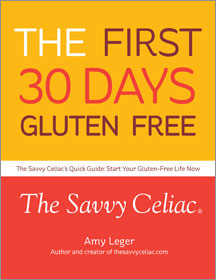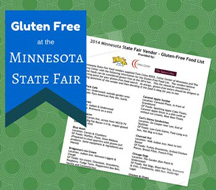Time to Bump Up Nutritional Value in Gluten-Free Foods, says Expert
October 1, 2010 by Amy Leger | G+ Amy LegerThe days leaning on highly refined white rice flour, potato and corn grains to make gluten-free products should get behind us. Shelley Case, gluten-free nutritionist extraordinaire, made that perfectly clear to the baking industry. When you take gluten out of the equation, foods can offer less nutrition. It’s up to us in our own kitchens and, as Case points out, gluten-free food manufacturers, to strive to make gluten-free foods more nutrient-rich.
Gluten-Free Nutrient Deficiencies
Research published in early 2010 by the journal entitled Nutrients, mentioned “previous studies have demonstrated that 20-38% of celiac patients have some nutritional deficiencies such as calorie/protein, dietary fibre, minerals and vitamins.” So…now I’m getting it….we become nutrient deficient when we have undiagnosed celiac disease because our gut can’t absorb it — and then some of us stay nutrient deficient after diagnosis because our gluten-free foods are lacking in fiber, protein and other vitamins and minerals.
According to an article on BakeryandSnacks.com, during the International Baking Industry Expo in Las Vegas this week, Case challenged industry officials to “focus on boosting the nutritional content of gluten-free products as well as enhancing texture and taste at the formulation stage.”
Increasing Nutrition
The Nutrients journal article investigated why our food lacks nutrients — but then ended up concluding that just by adding in gluten-free oats it would boost our food’s nutrient level. The report cited research that “demonstrated that the adding of three servings of gluten-free alternative grains, including oats and quinoa, positively impacts the nutrient profile (fibre, thiamine, riboflavin, niacin, folate and iron) of the grain portion of the gluten-free diet.”
The Challenges
So why not do it? One of the biggest obstacles is price. Even for me. The flour blend we use is highly refined: a combo of white rice flour, potato starch and tapioca starch — all ingredients many gluten-free manufacturers are using to create baked goods. It’s tough when my flour mix already costs double of what regular flour is. So it’s tough to make the cost triple that by purchasing more whole grain items. I know… I know…bad Mom. But I’m just being honest. Companies will need to commit to the nutrition mission in order to make this change back at the “office”. But I’m sure they’re thinking, “if we make that commitment and our product is higher in price, and the competition doesn’t make that pledge and they’re significantly lower in price — consumers will choose them.”
In my world it appears to be a never-ending cycle of balancing competition, bottom line and doing what’s right. In my own home I only have to deal with the latter two, but I do feel a tide changing. I may never entirely give up white rice flour, but there’s no reason why I can’t add more nutritional flours to formulate a more nutritious mixture for baking and cooking.
Tags: baking, celiac, gluten-free, nutrients, nutrition, vitamins



Leave a Reply